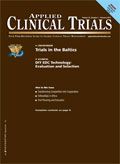Cutting Our Losses in Translation
Applied Clinical Trials
To reduce the time from bench to bedside we need to transform competition into cooperation.
As I write this column, we're midway through the NFL playoff season, when the haves root their competitive, winning teams through each sudden death round, while the have nots (losers like those of us from Chicago and Philadelphia) are anxiously following the search for new coaches and innovative plans to rebuild a team to make it playoff worthy in the shortest period of time. One could call this latter activity translational sports management, where ambition, vision, and hope are ideally converted into future success on the playing field—or so we can dream when training camp opens again anyway. Coincidentally, this season of hope also just precedes the salad days of spring training in baseball, where everyone's a winner until the actual games have to be played.

Wayne R. Kubick
Clinical development has the somewhat analogous concept of translational research, which, in the simplest sense, means steps taken to bring new treatments from the academic world to real medical practice—from bench to bedside. The National Cancer Institute's Dictionary of Cancer Terms defines "bench to bedside" as "a term used to describe the process by which the results of research done in the laboratory are directly used to develop new ways to treat patients." The definition of "translational research" is almost identical, though in that case the focus is described as developing new ways to "diagnose and treat disease."
No matter what we call it, the need is obvious. It is estimated that less than 1% of drug compounds discovered by researchers that are deemed worthy of initial testing ever make it to the pharmacy—pretty much long shot odds. And getting to market typically costs over a billion dollars over 15 or more years—a span of time that can affect many patient lifetimes.
Fortunately, there are many initiatives already underway that fit under the promising big tent of global translational research. Nearly a decade ago, the US National Institutes of Health's NIH Roadmap for Medical Research outlined a series of programs that provided an early boost to translational research, in the hope of addressing roadblocks and knowledge gaps. The NIH Roadmap was broad and highly ambitious, involving programs ranging from identifying new pathways to discovery in such areas as bioinformatics, molecular libraries, and nanomedicine, to reengineering the clinical research enterprise. The reengineering research program involved goals to improve regulatory processes, enable national electronic clinical trials and networks, and introduce new technologies for assessing disease. A third roadmap area involved activities to develop research teams of the future, by establishing advanced training programs; building collaborative partnerships involving academics, physicians, and patient communities; and developing public/private partnerships, a theme that continues to persist today.
Although references to the original NIH Roadmap are not as easy to find anymore, the NIH is now advancing similar goals through the NIH Common Fund and National Center for Advancing Translational Sciences (NCATS). The mission is "to catalyze the generation of innovative methods and technologies that will enhance the development, testing, and implementation of diagnostics and therapeutics across a wide range of human diseases and conditions and make translational science more efficient, less expensive, and less risky."
Many similar activities were further moved along by the FDA through its Critical Path Initiative, which, among other things, led to public/private partnerships like the Critical Path Institute and the Clinical Trials Transformation Initiative. More recently, TransCelerate Biopharma's consortium of major pharmaceutical companies was established to sponsor projects with the intent of improving the efficiency of research, advancing innovation, and solving common R&D challenges and obstacles in a cooperative, precompetitive environment.
Meanwhile, in Europe, the Innovative Medicines Initiative (IMI), a public/private partnership between the European Union and the European Federation of Pharmaceutical Industries and Associations, was created to "speed the development of better and safer medicines for patients," identifying translational research as one of its cornerstone areas for investment. Thus IMI's European Translational Information and KM Services project (eTRIKS) intends to provide a knowledge management technology platform to support IMI projects that will analyze and compare diverse collections of shared data for multiple studies and treatments. eTRIKS is intended as a resource for collaborative research, knowledge discovery, and knowledge management using data from clinical studies and pre-clinical studies, imaging data, genomics, proteomics, and data sources for biomarker discovery and validation.
Other comparable national initiatives abound elsewhere around the world, such as the Translational Research Informatics Center in Japan.
What kinds of projects are covered under the umbrella of translational research? Well, for IMI eTRIKS, translational research studies may involve working with clinical data and collected biological specimens from laboratory animals and study volunteers to generate biological profiles, and support simulations and predictive model development or validation (such as by helping to identify more effective animal models to use during pre-clinical testing to better predict how humans will react). Such projects can help identify new opportunities for drug development, or provide greater insight into potential safety issues that can help researchers identify more promising drug candidates, rapidly eliminate those likely to fail, and predict what populations are most likely to respond favorably during clinical testing— knowledge that ideally can be applied to help new drugs become more rapidly available to patients.
So in essence, you get lots of different types of data together all in one place, bang the data around, and see what you can learn. Then—and this is the critical translational part—figure out how to put what you learn into practice so that others can apply it to make a real difference for patients.
So translational research is a hot topic, and it seems as though nearly everyone everywhere is trying to solve similar problems. But alas, mostly on their own. Ironically, one possible observation is not that so many organizations are involved in activities related to translational medicine and transformational research, but rather that there are so many separate, similar initiatives operating concurrently around the world. It's difficult just to keep track of them all, much less coordinate them to avoid duplication of effort and maximize sharing of ideas.
Oddly, the Internet, that ubiquitous gateway to information and big data, is as much a culprit as enabler in this regard. Search engines are so prolific and indiscriminate that it's nearly impossible to chase every lead. You need to make choices, and often feel that rather than trying to find an existing wheel that will fit the specific research vehicle you're building in an unmarked junkyard of spare parts, it's simply easier just to reinvent one yourself.
This overlapping or duplication of effort can occur on many levels. For example, most scientific publications list references of prior work that may have informed the current research project—the question is how deeply and comprehensive this list should be or can be if the author is ever going to get around to saying anything new at all. And given the complexity of research projects in life sciences, it's pretty easy to rationalize that nobody else could possibly be working on the exact same thing anyway, so why bother reaching out too far?
Meanwhile governments and foundations fund myriad research projects, which often develop tools, lots of tools, that may support dissertations and publications but are then left along the wayside while others are exploring similar problems over and over again. Perhaps too many tools are being created, making for a complicated landscape of too many choices when someone is looking for help solving their own problem. Sure, funding research may lead to great new discoveries, but we need more alignment among global research projects in academia, government, and industry as well. Surely there are cases when the game is more likely to be won when we all learn to put our resources into the same team.
One possible avenue toward improved collaboration among translational researchers might be creating a global master registry or clearinghouse to tie together the various projects and information resources and connect researchers in the same way that we connect to other kindred spirits via social networks. Researchers exploring their topics could be informed of possible relationships—similar to how iTunes and Amazon.com informs us, when we're exploring a potential purchase, that people who have viewed this item in the past also purchased something else. We all need to get on the same page if we have hopes of solving common problems in a common manner quickly enough to truly reduce the gap between bench and bedside.
In clinical development we work in a field that stems from academic and scientific research, where careers are made through individual invention and discovery. It's not easy to reach across the aisle to others who may be working on similar problems, much less those across multiple time zones and cultures who speak different languages yet have a common need to improve human health. But to make great strides in translational medicine, to reduce the nearly two decades it currently takes to go from bench to bedside, we need to, above all, learn from each other, work together, and transform competition into cooperation. Or, in the oft-quoted words of Benjamin Franklin, "We must all hang together, or assuredly we shall all hang separately."
Wayne R. Kubick is Chief Technology Officer for the Clinical Data Interchange Standards Consortium (CDISC). He resides near Chicago, IL, and can be reached at wkubick@cdisc.org.

Including Women of Childbearing Age in Clinical Research
March 26th 2024In recognition of International Women's Month, we're featuring this recent talk between Associate Editor Miranda Schmalfuhs and Marie Teil, Global Head of UCB’s Women of Childbearing Age Program. They speak about the specific challenges women with chronic illnesses face when accessing appropriate treatment and participating in clinical trials, UCB's Women of Childbearing Age Program and it’s most successful strategies, and much more.
Improving Engagement While Maintaining Data Integrity & Validity
March 19th 2024In recognition of Women's Health Month, we're featuring this recent talk between Associate Editor Miranda Schmalfuhs and uMotif's Chief Product Officer, Julia Lakeland, discuss new technologies improving patient engagement and reducing the emotional and logistical burdens of participation, ethical considerations that should be addressed when implementing those technologies, while ensuring patient privacy, and much more.